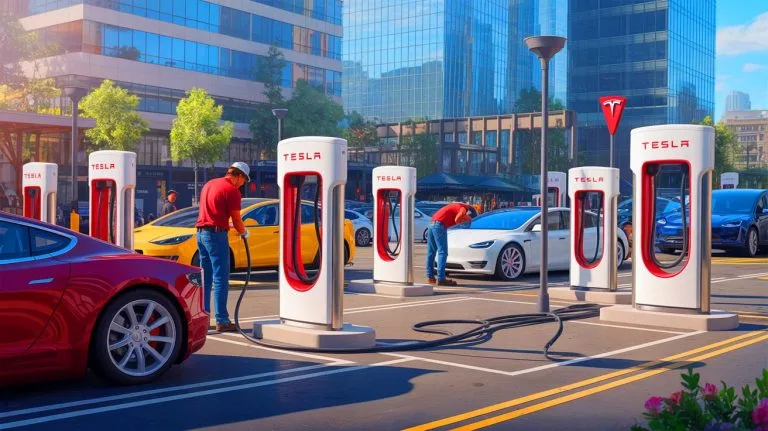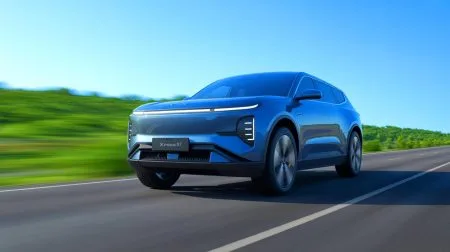| IN A NUTSHELL |
|
Tesla, once the uncontested leader in the electric vehicle market, faces a new era of challenges. Despite its storied rise, the company now grapples with declining sales, particularly in Europe, where Asian competitors such as BYD have started to dominate. Elon Musk, Tesla’s CEO, is not one to back down in the face of adversity. He has proposed an unconventional remedy to reassure investors: selling Tesla’s Supercharger stations directly to businesses at an entry price of $200,000 per unit. This move marks a significant shift in strategy, aiming to diversify revenue streams while the company navigates its current hurdles.
The Supercharger Strategy
In 2024, Tesla embarked on an ambitious expansion of its Supercharger network, adding nearly 1,000 stations and 10,000 new charging points worldwide. These stations quickly became a lucrative asset, contributing to a 64% rise in profits from services in just one quarter. Now, Tesla seeks to monetize this success by allowing other companies to purchase branded Superchargers.
The business model is straightforward: client companies pay for the equipment and installation, while Tesla provides the hardware, software, and technical support. This approach enables Tesla to establish a presence in commercial parking lots, business centers, and hotels while retaining control over management and maintenance. For businesses, it’s an opportunity to attract a new clientele and generate revenue from the rapid-charging stations.
However, the process is not without challenges. From site planning to local authority approvals and negotiations with electricity suppliers, the timeline from purchase to the first charge can range from 12 to 64 weeks. Additionally, Tesla requires a minimum order of four stations per site, representing a significant initial investment.
By outsourcing part of its charging network management, Tesla aims to grow its revenue while minimizing its own investments. This strategy also helps increase the density of charging points, a critical factor in convincing hesitant electric vehicle buyers. While this maneuver is bold, it signals a commercial shift: boosting service growth as vehicle sales slow.
Tesla’s Current Challenges
Just months ago, few industry experts would have predicted Tesla’s rapid slowdown. Yet, 2025 marks a pivotal year for the American automaker, with stagnating growth, declining revenues, and profits, and a lineup struggling to stay fresh. Hopes were pinned on the new Model Y L, but its absence from the European market has frustrated fans. Meanwhile, Chinese competition, led by BYD, has firmly established itself as the European market leader, stripping Tesla of its pioneering status.
Despite the bleak outlook, Elon Musk continues to make bold announcements. The CEO now focuses on developing humanoid robots, dubbed Optimus, which he touts as Tesla’s future, though results have been slow to materialize. The introduction of his robotaxi service earlier this year also forms part of his futuristic vision.
“$15,000 Down the Drain”: Tesla Customers Furious as Full Self-Driving Remains Stuck at Level 2
Will these efforts suffice to elevate Tesla’s valuation to $1 trillion over the next decade, as Musk has promised? The odds are steep, but the billionaire is not short on ideas to restore his company’s image, even if it means surprising—or unsettling—shareholders.
Competition and Diversification
Tesla’s sales decline, particularly in Europe, highlights the fierce competition from Asian automakers like BYD. These companies have managed to capture significant market share by offering affordable, reliable electric vehicles. Tesla’s strategy to sell Superchargers to businesses is a clear attempt to diversify revenue and offset its current automotive market weaknesses.
By licensing its Supercharger technology, Tesla hopes to leverage its brand and technology leadership in the charging infrastructure sector. This move allows the company to tap into a new revenue stream while maintaining a presence in the rapidly evolving electric vehicle ecosystem. As the landscape shifts, Tesla’s ability to adapt and innovate will be crucial in maintaining its competitive edge.
Furthermore, this strategic pivot reflects a broader trend in the automotive industry toward service-based revenue models. As traditional vehicle sales face increasing pressure, companies are exploring ancillary services to sustain growth. Tesla’s venture into charging infrastructure sales could serve as a blueprint for other automakers seeking to diversify their offerings.
The Road Ahead for Tesla
As Tesla navigates its current challenges, the company must balance short-term pressures with long-term goals. The decision to sell Superchargers to businesses represents a calculated risk, aiming to bolster revenue while diversifying its portfolio. However, the success of this strategy will depend on Tesla’s ability to execute effectively and overcome logistical hurdles.
Elon Musk’s vision for Tesla extends beyond vehicles, with projects like Optimus and robotaxis highlighting his ambition to redefine the company’s future. While these initiatives are promising, they require significant investment and development before they can contribute meaningfully to Tesla’s bottom line.
As the automotive industry continues to evolve, Tesla’s adaptability and innovation will be critical to its success. Can Tesla maintain its leadership in the face of mounting competition and shifting market dynamics, and what will be the next bold move in its pursuit of sustainable growth?
Did you like it? 4.5/5 (21)







Wow, selling chargers? Is this the beginning of the end for Tesla? 🤔
This is unexpected! Is Tesla really in such dire straits? 🤔
This is crazy! Is Tesla seriously struggling that much?